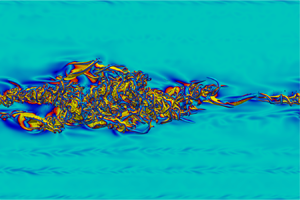Article contents
Receptivity and transition in a solitary wave boundary layer over random bottom topography
Published online by Cambridge University Press: 10 February 2021
Abstract

Direct numerical simulations are conducted to study the receptivity and transition mechanisms in a solitary wave boundary layer developing over randomly organized wave-like bottom topography. The boundary layer flow shows a selective response to broadband perturbations from the bottom, and develops streamwise-elongated streaks. When the streaks reach high amplitudes, they indirectly amplify streamwise-elongated vortices through modulating small-scale fluctuations and pressure fields. These stronger vortices in turn stir the boundary layer more effectively and further intensify streaks via the lift-up mechanism. This nonlinear feedback loop increases the sensitivity of the boundary layer to the roughness level and yields dramatic variations among cases sharing the same Reynolds number with differing roughness height. Three different local breakdown scenarios are observed depending on the amplitude of the streaks: (i) two-dimensional wave instabilities in the regions with weak streaks; (ii) inner shear-layer instabilities in the regions with moderate-amplitude streaks; and (iii) rapidly growing outer shear-layer instabilities in the regions with highly elevated high-amplitude streaks. Inner instabilities have the slowest growth rate among all transition paths, which confirms the previous predictions on the stabilising role of moderate-amplitude streaks (Önder & Liu, J. Fluid. Mech., vol. 896, 2020, A20).
Information
- Type
- JFM Papers
- Information
- Copyright
- © The Author(s), 2021. Published by Cambridge University Press
References
REFERENCES
Önder and Liu supplementary movie 1
Development of streamwise streaks in case h0.06. Contours show the distribution of the streamwise velocity at height z=0.5 (normalized with the Stokes length). The velocity at each time instant is normalized by the respective free-stream velocity.
Önder and Liu supplementary movie 2
Orderly transition in case h0.01. Contours show the magnitude of the vertical velocity at height z=1.3. The levels are normalized by the maximum free-stream velocity and span the interval [0.0022, 0.165].
- 2
- Cited by


